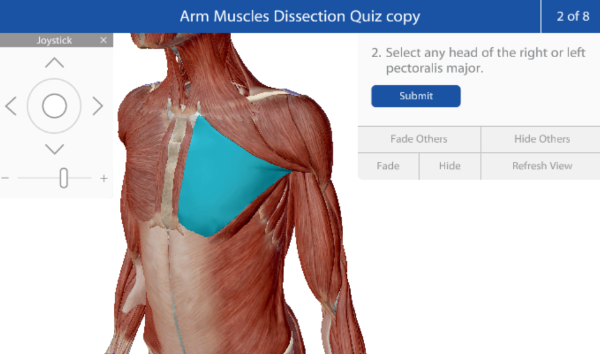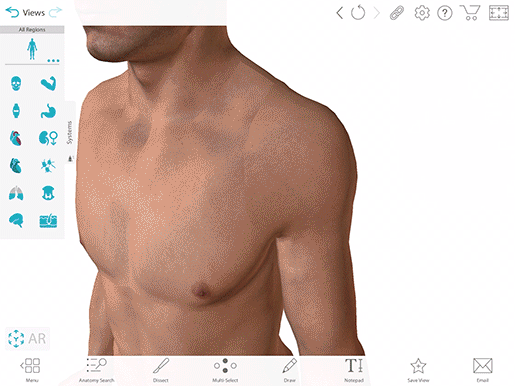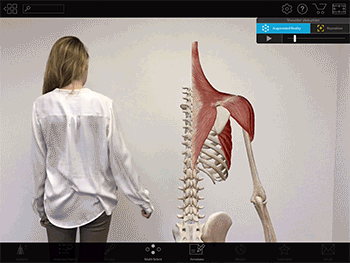Visible Body in a Hybrid Learning Environment: A Courseware Case Study with Professor Pat Carley
Posted on 9/17/21 by Laura Snider
Whether you’re considering purchasing Visible Body Courseware or you just want a few new teaching ideas for the upcoming school year, we’ve got some inspiration for you in this blog post! Dr. Pat Carley, who teaches in the physical therapy program at American International College (AIC), was kind enough to tell us all about how he used Visible Body Courseware in his gross anatomy courses this summer.
Below, we’ll go through how his students used Courseware during lab sessions and how he created a full lab practical exam in Courseware. We’ll also talk about how using 3D models helped Dr. Carley’s students earn higher grades and transfer their knowledge into palpation labs and clinical rotations.
Using Visible Body with team-based remote learning
Typically, the summer versions of Gross Anatomy I and II in AIC’s physical therapy program have around 40 students—this year, there were 38. Because of the condensed nature of summer semester courses, these students had two (remote) three-hour lab sessions in addition to a 2.5 hour palpation lab (in person) each week. Students used Visible Body across both the online and in-person sessions, as Dr. Carley explained: “We combine the two-hour virtual setting for the lab with the real face-to-face palpation lab setting. The students migrate their use and familiarity of Visible Body and use the Courseware resources on their phones. This helps them hone their palpation skills and carry forward the knowledge from the earlier virtual lab class.”
Dr. Carley went into further detail about how he used Courseware during the online lab sessions: “I incorporate the use of breakout rooms in Zoom in combination with weekly quizzes in Visible Body Courseware to create a remote team-based learning environment.
 A dissection quiz question in Visible Body Courseware's quiz interface.
A dissection quiz question in Visible Body Courseware's quiz interface.
For about a quarter of the lab time, the class will operate in groups of around five students per group, with each group in its own Zoom breakout room. While each team works through their assignments and quizzes together. I will stop by each breakout room to answer any questions the students may have. This approach helps to promote a more collaborative learning in the virtual setting using Visible Body as our virtual text.”
Dr. Carley emphasized that getting familiar with Courseware early in the course is key. Students were initially apprehensive about learning to use a new technology, but working in groups helped them teach one another how to use the models in Courseware.
Taking quizzes as a team also helped familiarize the students with Visible Body Courseware because they would teach and help each other in this format. When taking a quiz, the students in a group would challenge each other and answer each question the same way. “They take the quiz together, and so they have to really explore Visible Body together,” Dr. Carley said. “So if some are a little bit confused, the others are helping them out. They’re kind of teaching and supporting each other, which is great.” Also, if someone put down the wrong answer by accident, there was no need to worry—the team grade would still match the highest individual grade on the team, helping to reduce the level of student anxiety and foster better learning of complex content.
Building a lab practical in Courseware
One of the advantages Courseware offers is that instructors can use the quiz engine to create their own graded assessments composed of multiple choice or dissection questions. (We also have plenty of premade quizzes, including a full course of auto-grading labs.)
Dr. Carley made use of this feature to create both the mid-term and final lab practical exam for the students in his course. The mid-term practical contained 50 dissection questions while the final lab exam contained 100 dissection questions. The final covered structures from the first half of the course as well as the new material of the pelvis, lower extremities, chest, and abdomen.
Students had one minute to complete each question/structure identification. (Dr. Carley mentioned that in the regular, physical version of the lab practical, students would move through stations where they would have 30 seconds to identify each structure.) You can read more about creating and assigning timed quizzes here.
During the mid-term and final lab practicals, each student worked on their own, but they took the exam while on Zoom so that they could ask Dr. Carley questions or express any technical concerns while taking the exams. A few students needed to take their exams in the library to access faster/more reliable wifi while others had some minor and only periodic wifi issues in their home or dorm room.
Want to learn more about using Courseware for quizzes and exams? If you’re interested in reading more about how you can use specific features of the Courseware quiz engine to ensure academic integrity, check out this blog post. We’ve also got a deep dive on the pros and cons of remote proctoring technologies here.
How Visible Body's 3D models help students migrate knowledge out of the lab
Dr. Carley told us that one of his favorite things about Visible Body is that it helps students carry knowledge forward from their regular A&P classes into other parts of their education as future physical therapists.
Earlier, we mentioned that palpation labs are part of the gross anatomy courses. In these labs, students get used to evaluating the body via touch. Dr. Carley says that his students this summer enjoyed using Visible Body on their phones during these labs. The Fade feature made Visible Body an especially useful reference tool for palpation labs—students can fade the skin in a particular region to see the structures underneath.
 GIF created using Human Anatomy Atlas.
GIF created using Human Anatomy Atlas.
Similarly, the AR feature allows students to project Visible Body models onto people in the real world using their device’s camera. As we’ve mentioned in this lesson plan blog post, the AR feature is great for understanding the mechanics of muscle actions. Students also benefited from comparing how structures are illustrated in Visible Body’s models and how they look and feel on real human bodies.
 GIF created using Human Anatomy Atlas.
GIF created using Human Anatomy Atlas.
The knowledge and fun don’t stop there—the physical therapy students at AIC often bring Visible Body on their clinical rotations and use it for patient education! “They would show their patients while on their clinical rotations—’here’s that muscle, here’s what we’re talking about, here’s what it does,’” Dr. Carley elaborated. “And so their patients and clinical instructors have been really impressed with that ability in bringing that technology into the clinical settings, which theysay affords them with a very powerful tool in working with patients. They are finding overall that it’s helping them really get the information in their heads across to the patients.”
How to use Augmented Reality Mode in Human Anatomy Atlas on mobile.
Why Dr. Carley recommends Visible Body
Ultimately, Dr. Carley recommends teaching with Visible Body because it illustrates complex topics and improves students’ grades. “We’ve been finding as we morphed into Visible Body that we’ve been seeing the grades migrate upwards, which is great!” he said. “[It] also helps us with student retention, which is important to the physical therapy program and the college itself.”
In the classes he taught this summer, Dr. Carley used Visible Body to guide his students through challenging topics, such as the anatomy and physiology of the heart and lungs. He also told us about what we thought was absolutely the coolest use of Visible Body we’ve seen yet: presenting in court as an expert witness. Dr. Carley says that when giving testimony or depositions, Visible Body’s visuals made anatomical details that are sometimes abstruse and perplexing to laypeople a great deal clearer for the legal system. “If you can teach and describe anatomical relationships to those in the court using precise visuals provided by Visible Body, it helps identify the importance of what you’re trying to say,” Dr. Carley explained. “A picture is worth a thousand words.”
In addition, several students in the physical therapy graduate program at AIC have dedicated their capstone project to assessing the effectiveness of Visible Body. They have been compiling data about students’ grades in classes where Visible Body was implemented and have submitted their findings to the Journal of Allied Health Professionals for publication. We’re certainly excited to see their results!
If you’d like to hear more about Dr. Carley’s experience teaching a lab course with Visible Body, keep your eyes peeled for a webinar from him later this fall!
In the meantime, we’d recommend checking out these related blog posts:
- What Human Biology Instructors Learned from Teaching During COVID
- Visible Body Improves Student Performance: HAPS 2021 with Dr. Cindy Harley
- La Trobe University: Visible Body in Higher Education Anatomy Teaching
- Webinar with Dr. Luis Rosado: How Effective is Visible Body?
Be sure to subscribe to the Visible Body Blog for more anatomy awesomeness!
Are you an instructor? We have award-winning 3D products and resources for your anatomy and physiology course! Learn more here.



